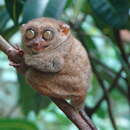Biology
provided by Arkive
Philippine tarsiers are nocturnal animals that are also active at dusk and dawn (2). They spend the day sleeping in dense vegetation or occasionally in a hollow tree, and then as the sun sets, they begin their search for insect prey. Philippine tarsiers are agile acrobats of the forest, making vertical leaps from tree to tree with ease (2). Their head can rotate nearly 360°, and this, along with their enormous eyes, gives them an excellent field of vision (2). Once an insect is spotted, the Philippine tarsier will carefully adjust its position and focus, and then leap forward to seize the prey in both hands (2), their slender fingers creating a cage in which to hold flittering insects (4). During the hours the Philippine tarsier is awake, its thin ears are almost constantly being furled or crinkled (2).
Generally seen in pairs of a male and female, the Philippine tarsier gives birth to a single young. Incredibly, the well-developed young weigh 25 percent of the mother's weight, a greater percentage than any other mammal (4). These large babies are well-furred, have their eyes open (2) (4), and are immediately capable of climbing and making short hops, although full leaps are not undertaken until one month of age. As the mother moves around the trees, the young will cling to her abdomen or be carried in her mouth. At 42 days of age, the young Philippine tarsier begins to capture its own insects, and shortly after this it is weaned. In captivity, a Philippine tarsier lived for just over 13 years (2).
Conservation
provided by Arkive
There are currently no parks or reserves within the range of the Philippine tarsier. Protected areas are very likely to mitigate the threat of habitat loss to the tarsier, and thus surveys to determine where protected areas would be most beneficial are needed (5).
Description
provided by Arkive
The most notable feature of this extraordinary looking primate is its enormous eyes (2); tarsiers have the biggest eyes relative to their body weight of any mammal (4). As well as huge eyes, the Philippine tarsier has large, membranous ears set on its rounded head. It has short forelimbs, but greatly elongated hindlimbs, a feature which is reflected in this species name as tarsier refers to the elongated tarsal or ankle region (2). Its long digits culminate in rounded pads that provide the tarsier with effective grip on any surface. The fully opposable first toes also help the tarsier grip to slender branches (2). All the fingers and toes have flattened nails, except for the second and third toes which have claw-like nails used in grooming (2). The Philippine tarsier has wavy fur with a silky texture, ranging in colour on the upperparts from buff or greyish-brown to dark brown. The fur on the underparts is buff, greyish or slate (2). The tail is naked apart from a few short hairs on the tip, and is used as an extra support when clinging to an upright branch (2).
Habitat
provided by Arkive
The Philippine tarsier preferentially inhabits secondary forest, scrub, and clearings with thick vegetation, although it also been found in primary forest and mangroves (2).
Range
provided by Arkive
Endemic to the Philippines, where it occurs on the islands of Samar, Leyte, Dinagat, Siargao, Bohol, Mindanao, Maripipi and Basilan (1) (2).
Status
provided by Arkive
Classified as Data Deficient (DD) on the IUCN Red List 2007 (1), and listed on Appendix II of CITES (3).
Threats
provided by Arkive
Numbers of Philippine tarsiers are falling as their forest habitat is destroyed (5). However, the IUCN deemed that there is insufficient information to determine the extent to which the Philippine tarsier may be threatened, and so it is currently assessed as Data Deficient (1).

